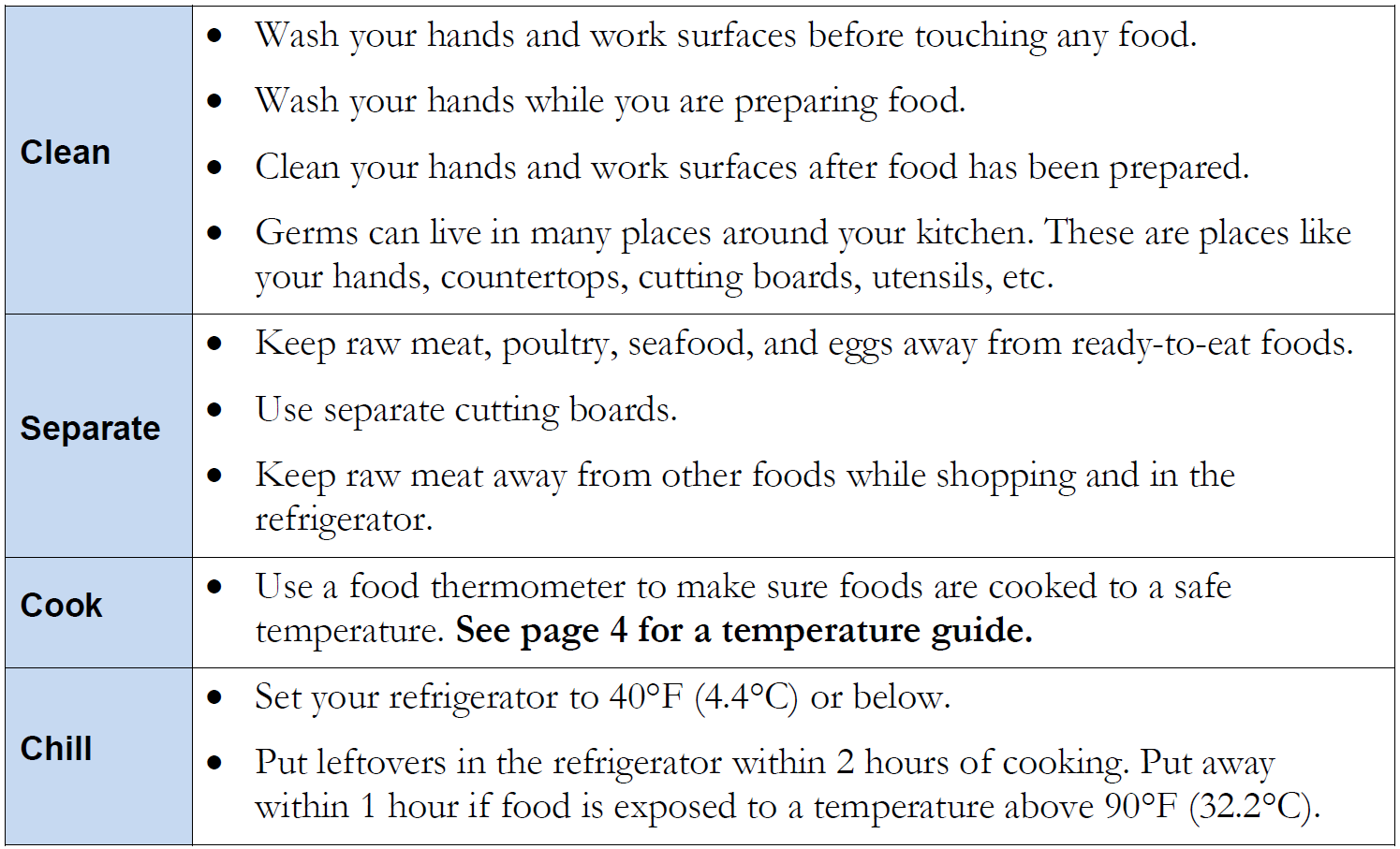Food Poisoning

When people eat food that contains germs or toxins (contaminated food), they can develop anything from a mild illness to a serious disease. Food is very safe in the United States. However, millions of Americans get sick each year from germs, or their toxins, that can be in food. This is called food poisoning. The most common food poisoning germs are:
- Hepatitis A
- Norovirus
- E. Coli (Escherichia coli)
- Listeria
- Salmonella
- Botulism (Clostridium botulinum)
- Shigella
- Campylobacter
- Staph (Staphylococcus aureus)
Causes
Food poisoning is usually caused by bacteria that have formed toxins in food. This makes it unsafe to eat. Food poisoning is commonly associated with raw eggs, raw or undercooked meat, raw vegetables, unwashed fruits, raw seafood, and unpasteurized (raw) milk. Dirty or unclean water can also cause food poisoning.
Signs and Symptoms
Sickness generally lasts from a few hours to several days. Symptoms can start within hours, days, or weeks after being exposed to the contaminated food. Most types of food poisoning cause one or more of the following symptoms:
- Fever
- Nausea
- Throwing up (vomiting)
- Watery or bloody diarrhea
- Belly (abdominal) pain and cramps
Treatment
Most cases of food poisoning get better in 5 to 10 days without treatment. Some things you can do to help your child while they’re sick include:
- Drinking a lot of liquids. Some food poisoning symptoms can cause dehydration. This means that there is not enough water in your child’s body.
- Call your child’s doctor or health care provider if they have any of these signs of dehydration:
- No energy
- Sunken eyes
- Dry or sticky mouth
- Not peeing as much
- Soft spot on the head that pulls in
- For infants under 6 months of age, give Pedialyte, breast milk, or formula.
- For infants over 6 months of age, give Pedialyte, popsicles, or flavored deinks diluted with water (3-to-1).
- Call your child’s doctor or health care provider if they have any of these signs of dehydration:
- Giving medicine if directed by their doctor or health care provider. Do not use over-the-counter (OTC), anti-diarrhea medicine unless they tell you to.
- Adding solid foods, like crackers, or dry cereal, until your child can eat regular foods.
- Containing your child's doctor or health care if they're not getting better to see if an antibiotic may be needed.
When to Call the Doctor
- Call your child's doctor or health care provider if they:
- Do not get better in 24 hours.
- Have symptoms that are getting worse.
- Have stomach pain that is worse than a few cramps.
- Quickly get a fever over 101° Fahrenheit (F) or 38° Celsius (C) under their arm.
- Have diarrhea that gets worse or has blood in it (more than just a steak).
- If you have any other questions, call your child's doctor or health care provider.
Prevention
Food poisoning can't always be prevented. However, these 4 steps will help reduce your risk of getting sick:

Handling Food
Follow the directions below when eating these foods:
- Eggs - Cook eggs until they are firm. Avoid recipes that contain raw eggs. Do not eat raw cookie dough.
- Fruits and vegetables - Scrub and clean the outside of all fruits and vegetables.
- Meats - Cook meat completely.
- Do not cook meat intended for later use. If you need to cook ahead, chill the cooked meat quickly.
- Only marinate raw meat in the refrigerator. Do not reuse the marinade.
- Cut into the meat when grilling to make sure it's done. You can also use a food thermometer to check.
- Do not put cooked meat on a plate where raw meat was.
- Coolers - Keep the cooler inside an air-conditioned car. Never keep it in the trunk. Replace the ice if it melts. Keep drinks in their own cooler.
How to Use a Food Thermometer
- Roasts - Insert halfway through without touching the bone.
- Hamburgers, steaks, chops - Insert into thickest part of the meat.
- Poultry - Insert into thickest part of the thigh.
Temperature Guide
Foods should be cooked to the temperature shown below. This will help prevent food poisoning.

Content source: Food and Drug Administration - Safe Food Handling
HH-I-294 Revised 4/22, Copyright 2009, Nationwide Children’s Hospital



